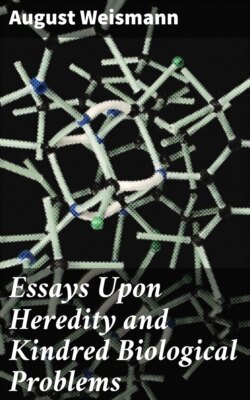Читать книгу Essays Upon Heredity and Kindred Biological Problems - Weismann August - Страница 14
На сайте Литреса книга снята с продажи.
Note 10. Intermingling during the Fission of Unicellular Organisms[30].
ОглавлениеTable of Contents
Fission is quite symmetrical in Amoebae, so that it is impossible to recognise mother and daughter in the two resulting organisms. But in Euglypha and allied forms the existence of a shell introduces a distinguishing mark by which it is possible to discriminate between the products of fission; so that the offspring can be differentiated from the parent. The parent organism, before division, builds the parts of the shell for the daughter form. These parts are arranged on the surface of that part of the protoplasm, external to the old shell, which will be subsequently separated as the daughter-cell. On this part the spicules are arranged and unite to form the new shell. The division of the nucleus takes place after that of the protoplasm, so that the daughter-cell is for some time without a nucleus. Although we can in this species recognise the daughter-cell for some time after separation from the parent by the greater transparency of its younger shell, it is nevertheless impossible to admit that the characteristics of the two animals are in any way different, for just before the separation of the two individuals a circulation of the protoplasm through both shells takes place after the manner described in the text, and there is therefore a complete intermingling of the substance of the two bodies.
The difference between the products is even greater after transverse fission of the Infusoria, for a new anus must be formed at the anterior part and a new mouth posteriorly. It is not known whether any circulation of the protoplasm takes place, as in Euglypha. But even if this does not occur, there is no reason for believing that the two products of division possess a different duration of life.
The process of fission in the Diatomaceae seems to me to be theoretically important, because here, as in the previously-mentioned Monothalamia (Euglypha, etc.), the new silicious skeleton is built up within the primary organism, but not, as in Euglypha, for the new individual only, but for both parent and daughter-cell alike[31]. If we compare the diatom shell to a box, then the two halves of the old shell would form two lids, one for each of the products of fission, while a new box is built up afresh for each of them. In this case there is an absolute equality between the products of fission, so far as the shell is concerned.
